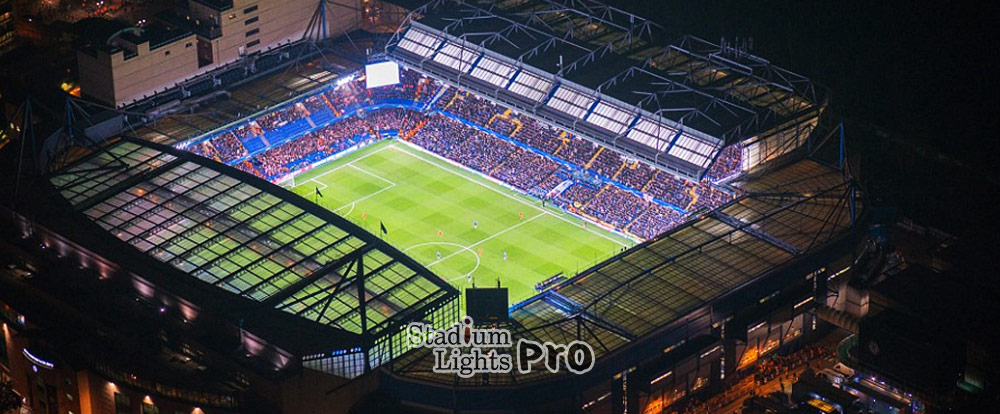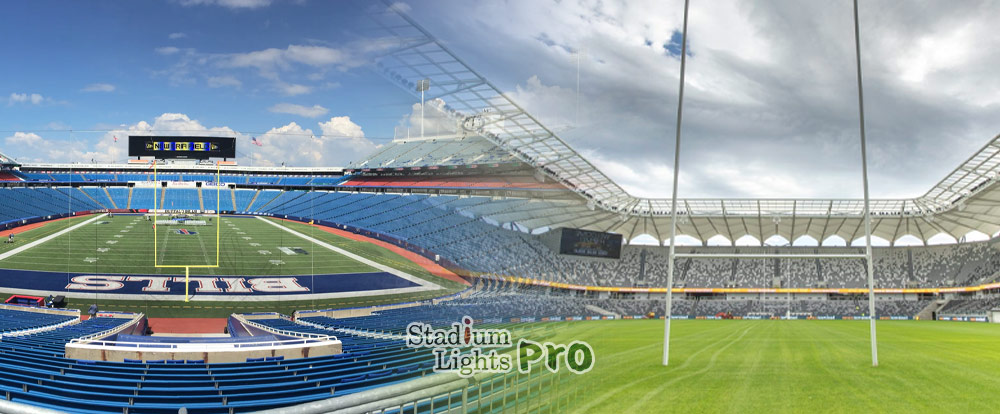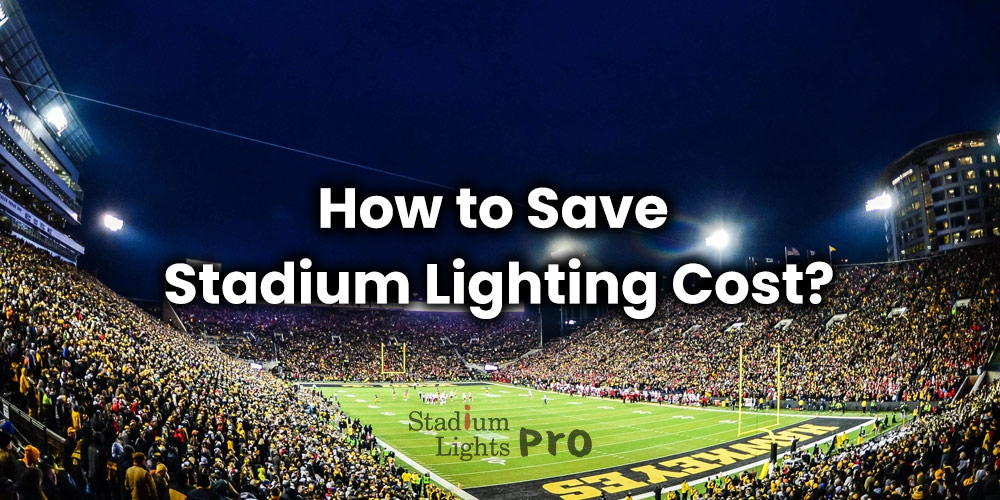This article discusses ways to reduce or save on stadium lighting costs. It suggests several strategies, such as upgrading to LED lighting, using dimming and control systems, and utilizing natural light, solar power, and occupancy sensors. It also recommends regular maintenance, energy-efficient financing options, and negotiating better energy rates, as well as using energy-efficient appliances and equipment and conducting an energy audit. All of these strategies can help reduce energy consumption and costs, ultimately helping to save money on stadium lighting.
Table of Contents
Toggle1. Upgrade to LED lighting

Upgrading to LED lighting is one way to reduce stadium lighting costs. LED lights are more energy efficient than traditional lighting systems, which means they use less electricity and generate fewer greenhouse gas emissions. They also have a longer lifespan, which means they need to be replaced less frequently, resulting in maintenance cost savings.
To upgrade to LED lighting, you will need to consider the specific needs of your stadium, including the size and layout of the space, the type of events held there, and the desired lighting levels. You will also need to factor in the upfront costs of the upgrade, which may include the cost of purchasing and installing the new LED lights, as well as any associated labor and materials costs.
While the upfront costs of upgrading to LED lighting may be significant, the long-term energy and maintenance cost savings can make it a worthwhile investment. In addition, upgrading to LED lighting can improve the overall lighting quality in the stadium, which can enhance the experience for attendees and improve the visibility of the events held there.
2. Use dimming and control systems
Using dimming and control systems is a way to reduce stadium lighting costs by adjusting the intensity of the lighting based on the needs of the event. This can help reduce energy consumption and costs.
There are several types of dimming and control systems available, including manual systems, automatic systems, and networked systems. Manual systems require someone to manually adjust the lighting levels, while automatic systems can be programmed to adjust the lighting based on predetermined conditions. Networked systems allow for centralized control and monitoring of the lighting from a single location.
Using dimming and control systems can offer a number of benefits, including energy cost savings, improved lighting quality and flexibility, and an enhanced experience for attendees. We need to consider the compatibility with existing lighting systems, the cost of purchasing and installing the system, and any training and maintenance requirements when deciding whether to use dimming and control systems.
3. Use natural light

Using natural light is another way to reduce stadium lighting costs. There are several ways to utilize natural light in a stadium setting:
Install skylights
Skylights can bring natural light into the stadium, reducing the need for artificial lighting during the day.
Use light tubes
Light tubes are a type of skylight that use a reflective tube to bring natural light into the stadium from a remote location, such as the roof.
Use windows
If the stadium has windows, consider opening them up during the day to allow natural light to enter the space.
Use transparent or translucent materials: Using transparent or translucent materials in the roof or walls of the stadium can allow natural light to enter the space.
Using natural light can help reduce energy costs and improve the overall lighting quality in the stadium. It can also help create a more pleasant and comfortable environment for attendees.
4. Use solar power
Using solar power is another way to reduce stadium lighting costs. Solar panels can be installed on the roof or in other areas around the stadium to generate electricity from the sun’s energy. This electricity can be used to power the lighting in the stadium, as well as other electrical systems and appliances.
Using solar power can help reduce energy costs and reduce the stadium’s carbon footprint. It can also provide a source of backup power in case of a power outage.
However, there are a few considerations to keep in mind when using solar power in a stadium setting:
Cost
Installing solar panels can be a significant upfront investment. We can consider the long-term cost savings and environmental benefits when deciding whether to invest in solar power.
Location
The location and orientation of the stadium can affect the effectiveness of solar panels. We should assess the solar potential of the site before installing solar panels.
Maintenance
Solar panels require regular cleaning and maintenance to operate at their optimal level.
Grid integration
By carefully considering these factors, using solar power can be a cost-effective and sustainable way to reduce energy costs and improve the sustainability of a stadium.
5. Use occupancy sensors
Using occupancy sensors is another way to reduce stadium lighting costs. Occupancy sensors are devices that detect when an area is not being used and automatically turn off the lights in that area. This can help reduce energy consumption and costs by ensuring that lights are only turned on when they are needed.
There are several types of occupancy sensors available, including passive infrared (PIR) sensors, ultrasonic sensors, and microwave sensors. PIR sensors detect movement using infrared energy, ultrasonic sensors detect movement using sound waves, and microwave sensors use microwaves to detect movement.
Using occupancy sensors can offer a number of benefits, including energy cost savings, improved lighting control and flexibility, and enhanced security.
6. Conduct regular maintenance
Conducting regular maintenance is an essential way to reduce stadium lighting costs. Regular maintenance can help ensure that the lighting system is operating at its optimal level, which can help reduce energy consumption and costs.
There are several types of maintenance that may be necessary for stadium lighting systems, including:
Cleaning
Dust, dirt, and other debris can accumulate on light fixtures, which can reduce their effectiveness and increase energy consumption. Regularly cleaning the fixtures can help improve their performance and reduce energy costs.
Inspection
We need to regularly inspect the lighting system for signs of wear and tear, such as damaged or burnt out bulbs, frayed wires, and loose connections. Identifying and addressing these issues can help prevent costly repairs and improve the overall performance of the lighting system.
Repairs
When problems are identified during inspection, we should promptly repair them to prevent further damage to the lighting system.
Upgrades
As technology advances, it may be beneficial to upgrade to more energy-efficient lighting systems or components. Upgrading can help reduce energy consumption and costs, as well as improve the overall lighting quality in the stadium.
By conducting regular maintenance and addressing any issues that arise, you can help reduce energy consumption and costs, and ensure that the lighting system is operating at its optimal level.
7. Consider energy-efficient financing options
There may be financing options available that can help offset the upfront costs of upgrading to energy-efficient lighting systems in a stadium. These financing options can help reduce overall costs and make it easier for the stadium to transition to more energy-efficient lighting.
Some potential financing options for energy-efficient lighting upgrades include:
Energy performance contracts
An energy performance contract is a type of financing that is based on the energy savings that result from the upgrade. The energy savings are used to pay for the upgrade, with the goal of achieving net zero or positive cash flow from the project.
Property assessed clean energy (PACE) financing
PACE financing is a type of financing that is secured by a property’s value and is used to fund energy-efficient upgrades. The financing is repaid through an assessment on the property’s tax bill.
Leasing
Instead of purchasing the lighting equipment outright, you can lease it from a vendor. The vendor is responsible for installing, maintaining, and replacing the equipment as needed, and you pay a monthly fee for its use.
Grants and incentives
There may be grants and incentives available from federal, state, or local governments or utility companies to help offset the costs of upgrading to energy-efficient lighting.
By considering energy-efficient financing options, you can help reduce the upfront costs of upgrading to energy-efficient lighting systems and make the transition more affordable.
8. Negotiate better energy rates
If your stadium is using a significant amount of energy, you may be able to negotiate better rates with your energy provider. This can help reduce energy costs and save money on lighting expenses.
There are a few things to consider when negotiating energy rates:
Research the market
It can be helpful to research the rates offered by other energy providers in your area to get an idea of what is a competitive rate. This can give you a better understanding of what to expect and what to negotiate for.
Identify your energy needs
Knowing your energy needs and usage patterns can help you negotiate a rate that is tailored to your specific needs. For example, if your stadium has high energy needs during certain times of the day or year, you may be able to negotiate a rate that reflects this usage pattern.
Understand your options
There may be different rate options available, such as fixed rate, variable rate, or time-of-use rate. Understanding the pros and cons of each option can help you negotiate a rate that works best for your stadium.
Consider a long-term contract
Some energy providers may be willing to offer a lower rate in exchange for a long-term contract. This can provide stability and predictability in energy costs, but it is necessary to carefully review the terms of the contract before committing to it.
By negotiating better energy rates, you may be able to save money on energy costs and reduce the overall cost of lighting in your stadium.
9. Use energy-efficient appliances and equipment
Using energy-efficient appliances and equipment is another way to reduce energy costs in a stadium. Energy-efficient appliances and equipment are designed to use less energy than traditional models, which can help reduce energy consumption and costs.
Some examples of energy-efficient appliances and equipment that may be used in a stadium include:
LED light flood light
LED lights are more energy efficient than traditional incandescent bulbs, which means they use less energy and have a longer lifespan.
Energy-efficient HVAC systems
Heating, ventilation, and air conditioning systems can use a significant amount of energy in a stadium. Energy-efficient HVAC systems can help reduce energy consumption and costs.
Energy-efficient appliances
Energy-efficient appliances, such as refrigerators, ovens, and dishwashers, can help reduce energy consumption and costs in a stadium.
Energy-efficient electronics
Energy-efficient electronics, such as computers, monitors, and printers, can also help reduce energy consumption and costs in a stadium.
By using energy-efficient appliances and equipment, you can help reduce energy consumption and costs, ultimately saving money on lighting and other energy expenses in your stadium.
10. Conduct an energy audit
An energy audit is a process that assesses the energy usage and efficiency of a building or facility, such as a stadium, and identifies opportunities for improvement. Conducting an energy audit can help reduce energy costs and improve the energy efficiency of a stadium.
During an energy audit, an auditor will typically:
Review energy bills and usage data
The auditor will review energy bills and usage data to identify patterns and areas of high energy consumption.
Inspect the building
The auditor will inspect the building and its systems, including lighting, HVAC, appliances, and electronics, to identify any inefficiencies or problems.
Analyze the data
The auditor will analyze the data collected during the review and inspection to identify opportunities for improvement and potential cost savings.
Recommendations
The auditor will provide recommendations for improving the energy efficiency of the building, which may include upgrading to energy-efficient lighting, appliances, and equipment, or implementing energy conservation measures.
By conducting an energy audit and implementing the recommendations, you can help reduce energy consumption and costs, ultimately saving money on lighting and other energy expenses in your stadium.
Conclusion
There are several strategies that can be used to reduce or save on stadium lighting costs, including upgrading to LED lighting, using dimming and control systems, utilizing natural light, solar power, and occupancy sensors, conducting regular maintenance, considering energy-efficient financing options, negotiating better energy rates, and using energy-efficient appliances and equipment. By implementing these strategies, you can help reduce energy consumption and costs, ultimately saving money on lighting expenses in your stadium. Conducting an energy audit can also help identify opportunities for improvement and potential cost savings. By carefully considering these strategies and implementing the most appropriate ones for your stadium, you can help reduce energy costs and improve the sustainability of your facility.
If you are considering upgrading or improving the lighting in your sports facility or stadium, we encourage you to contact us. As a professional stadium lighting company, we offer free lighting design and consultation services for sports and stadium lighting projects. Our team of experienced professionals can work with you to understand your specific needs and goals and develop a lighting solution that meets your requirements. We can help you choose the right lighting products and design a lighting layout that is energy-efficient and cost-effective. Contact us today to learn more and schedule a consultation.

